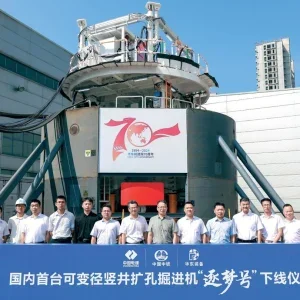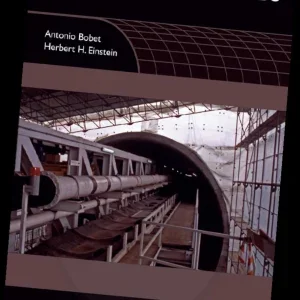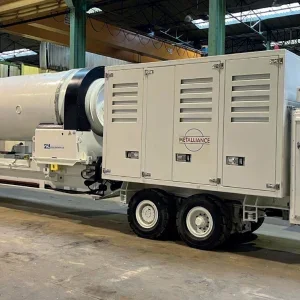Theodolites are synonymous with precision surveying, but, apart from the telescope and tribrach, modern versions have little in common with their predecessors, featuring, as they do, digital readouts, multiple automatic functions and laser-based accurate distance measurement that does away with the tape. Whereas early electronic systems were limited by their fragility and excessive weight of power sources, modern instruments can be set up in most tough tunnelling environments and, in many cases, left to operate remotely in a protected position due to the introduction of motorised functions.
It is remote-controlled, motorised and automatic functions of high accuracy that have enabled the broader use of theodolites, particularly in monitoring of small movements in the ground or what is connected to it including tunnel profiles, surface subsidence and heave and movements of related structures such as building being tunneled under. Their robotic operations allow a large number of stations to be covered in each sweep, much more than would be practical in conventional surveying. This makes it more likely to pick up problem are as that could otherwise be missed. Dedicated data processing with specific reporting functions of warning and alarm situations brings important values to the attention of surveyors and project managers.
Underground rapidly operated or automatic instruments sited in carefully planned locations mean that survey teams need rarely, if ever, have to interfere with the progress of tunnelling, and vice versa. Thus the productivity of tunnelling as well as surveying is improved.
Theodolites & scanning
The precision and reliability of Leica Geosystems instruments means they are found in a wide variety of tunnel projects for both underground measurements and monitoring for any disturbance at the surface. The Leica range are direct descendents of the Wild Heerbrugg theodolites that have be widely used underground. Applications range from sewer work in East London, to the recent breakthrough of the world’s longest rail tunnel, the Gotthard Base Tunnel. Leica instruments have been used in a wide range of activities throughout the Gotthard project.
The Gotthard tunnel client’s surveyor, Vermessungsingenieure Gotthard- Basistunnel (VI-GBT), has had the main task of ensuring the correct positioning of the tunnel bores with set-out and check surveys using Leica total stations, digital levels and optical plummets. “Put simply, our duty was to see that the hole was built in the right place,” commented Ivo Schaetti, senior engineer with VI-GBT. The client, AlpTransit Gotthard, required an accuracy of 100mm transversely and 50mm vertically over the whole length of the 57-km tunnel.
An extension of the application of laser theodolites was the development of underground excavation profiling, pioneered by Amberg Technologies. Something of an advanced development curiosity in early days, profiling and scanning have become important techniques to increase tunnelling efficiency, especially in larger projects, both in terms of overall size and the dimensions of the excavations. This has come about by a successful integration of Amberg software and instruments that have lately been developed into reflectorless and robotic total stations and 3-D scanners using advanced lasers.
A latest application has been New York’s No.7 Line metro extension including its major caverns under the congested urban environment of Manhattan. The S3II Tunnel Constructors JV of Shea, Skanska and Schiavone employed an Amberg 5003 Profiler. This is a high-speed laser scanner that employs the Amberg Positioning method (APM).
The Amberg TMS (Tunnel Measurement Systems) Solution offers several dedicated tunnel construction functions in software from setting out and check surveys to complete dimensional data. An extension of TMS Setout is TMS Setout Plus that enables the tunnelling crew to perform routing set out tasks themselves, removing the need for frequent surveyor site visits. The established TMS Profile enables the excavation profile to be checked accurately, whilst TMS Tunnelscan uses the latest scanner technology meets full dimensional data requirements with full mapping of the excavation surfaces at maximum speeds.
Amberg continues to break sales records for TMS Tunnelscan system. This instrument package is a laser-based scanning system of modular structure, combining hardware and software to scan the excavated surface to check of accuracy including, as examples, overbreak and underbreak in drill-and-blast tunnelling and the amount of sprayed concrete required to meet specified dimensions. Data output provides comprehensive documentation as has been shown in Helsinki Airport’s Ring Rail Line where it enabled precise invoicing of the tunnelling work and efficient use of time for data acquisition to processing and output.
Leica’s latest development of its ScanStation is the C10 all-in-one platform. The compact unit now includes a tilt sensor, battery, controller, data storage, auto-adjusting video camera and a laser plummet as well as the scanner itself. The addition of the new Smart X-mirror allows the operator to use its spinning mirror to perform a full-dome scan in a few minutes, thus affording major productivity advances.
The latest digital laser theodolites from Topcon (DT-200 series) feature the same absolute circle reading technology as employed in Topcon’s total stations, for high accuracy and reliability.
Sokkia has released a new range of robotic total stations, the SRX, designed mainly for autotracking and distance measurement. The four models feature a new laser system for increased reliability in prism tracking, plus new motors and drive mechanism.
Guidance
In addition to distance measurement, lasers have had another major effect on underground surveying, that of providing a semi-permanent reference of direction. As lasers became more robust and accurate, that simple reference for direction could be used for additional functions to replace manual marking out of excavations. Now laser-based guidance can be used to guide not only TBMs, but now also road headers and to provide a reference for drill hole patterns in drill-and-blast tunnelling.
Zed has been a leading developer of TBM guidance systems from 1975, originally based on a laser beam striking an active target. In the basic system, curves are negotiated by manual inputting of precalculated offsets. Further levels of sophistication use global co-ordinates in three dimensions with the required tunnel path defined by pre-programming the co-ordinates throughout, using the laser beam and distance travelled as reference.
Now there are several more companies offering increasingly sophisticated guidance and related measuring systems that, in some cases, can now be integrated into complete TBM control and management packages.
Very often a basic guidance system has to be modified to suit the particular circumstances of the project. VMT has developed a wide range of systems not only for TBM guidance but also roadheader guidance, segmental lining erection planning, segment ring movement monitoring and complete TBM management systems.
Another example of special guidance design is the Linthal 2015 hydropower project in Switzerland where PPS (Poltinger Precision Systems) provided a guidance system for an Aker Wirth TBM to bore at a constant inclination of 24 per cent over 3800m. Since the TBM is of 8m diameter, the guidance and steering must maintain exceptional accuracy since the previous maximum diameter for steeped inclined TBM drives has only been 6m.
Quirin Poltinger explained, “This project underlines two main characteristics of PPS; customer-orientated and flexible adaption to specific project needs. To meet customers’ expectations not only the hardware but also the software have been improved to fit the needs of the specially designed TBM.
In another recent application of PPS guidance technology, its roadheader system used on the Devil’s Slide road tunnel project n California achieved offsets within 10mm with respect to the tunnel axis at the roadheader’s recent breakthrough.
Other established manufacturers and suppliers of excavation guidance systems include taccs with the acs system and its news lining support ring development view in TBM control, and Geodata of Austria with its Tauros TBM and roadheader guidance systems amongst a range of surveying solutions. Recently, Geodata has entered into a partnership with Sokkia to offer combined expertise in optical 3-D monitoring, setting out and profile management in tunnelling.
Geodata has also been a leading participant in research and development projects within the Europe-wide Tunconstruct project including the Underground Construction Information Systems (UCIS) with Geodata’s Kronos package, plus the advanced concept of virtual reality visualisation of data.
An alternative approach is the heart of TEDSS (Tunnels Engineers Directional Survey System) promoted by Alignment Surveys and is currently being used by Costain in the Ovingdean drives of the new Brighton & Hove Wastewater Treatment project. The system uses a gyro theodolite over the 1700-m drive. At approximately 700m, Costain survey manager Nigel Drayton commented, “TEDSS has proven to be simple to use and maintain, and require minimal training for the engineers and surveyors. It has shown itself to be well suited for use in a small diameter TBM (2.44m i.d. in this case), where space is a critical issue. Being able to switch prisms on the curves has proved to be a major advantage. I would recommend TEDSS for similar small TBM-bored tunnels having small diameters, tight radius bends and limited survey windows.
Previously TEDSS had been used on the last major Belfast Sewer Project with similar application advantages in avoiding frequent moves of a laser system on curves. Project manager Paul Ronicle said, “The gyro system allows multiple targets, which allows greater flexibility, especially when negotiating a succession of curves. The system gave us better productivity, was accurate and extremely reliable.”
Ground instrumentation
Ground instrumentation for tunneling projects has a more established position in the principle of remote, passive monitoring, but still has a vital role to play in providing project managers with an overall picture of what is going on with the ground and linked structures. In spatial ground and structure monitoring, instruments such as inclinometers and extensometers provide information that would be laborious or impossible to obtain by conventional surveying.
Another activity in which inclinometers play an important role is in borehole surveying, whether for site investigation or long-hole probing. Sherborne Sensors was set up in 2002 by managing director Mike Baker and sales & marketing director Robin Butler to offer small, high-precision instruments including inclinometers and accelerometers. Both men have backgrounds in manufacturing such devices for international markets in industrial, aerospace and military applications where, in the latter case, environmental conditions could not be more demanding. Therefore, although pitching to small-diameter borehole and seismic surveying applications for the first time, the T820 series of inclinometers has been developed for equally demanding conditions.
This is another sector in which miniaturisation has major application advantages. Sherborne’s T820 gravity referenced, dual axis inclinometer is only 23mm in diameter (the company’s smallest) and 161mm long.
Robin Butler explained to T&TI that the instrument’s stainless steel housing makes it more rigid and therefore less prone to angular errors than the main alternative of aluminium alloy. The measuring range is +14 to +60 degrees, and normal operating temperature range -18 to 70 degrees C, perhaps opening up its use for ground freezing conditions. Connections can be totally sealed (to IP67), as in the T823, or equipped with solder pin terminals as in the T825.
The inclinometer is housed with other instruments in a surveying probe for use between drilling operations, or is robust enough to work with MWD (measurement while drilling) as has been proven in larger diameter geometric studies in Russia at depths to 12,000m where retraction of the drill string is prohibitively expensive. The T820 series has a 1000G shock resistance claims Butler.
Mike Baker explained, “The T820 series has been designed to operate in the smallest of areas and can withstand high levels of mechanical shock without any degradation in performance.”
Custom design is a Sherborne speciality with around 50 per cent customised and 55 per cent exported. The new inclinometers can be used in any hard-to-access area, for example behind reinforcement, to check for uneven movement.
Tilting
The latest instrument in the wide Geokon range is the 6165 MEMS tilt beam (MEMS = MicroElectricalMechanical System). This is designed to measure any tilting or differential subsidence by being attached to structures, whether horizontally or vertically. Tilt beams can be coupled together in long horizontal strings if differential settlement over a longer distance needs to be checked such as on embankments, along existing tunnels, railways etc. Vertical strings can be used to measure wall or piling deformation.
Recent applications of Geokon tilt beams and other spatial instrumentation include the Blackfriars Station redevelopment project in London, the Busan Subway 308 in South Korea and the FCC metro Line 7 in Madrid.
Headquartered in Lucknow, India, Encardio-Rite manufactures a wide range of instrumentation of all types. Exports have been made not only to Asia but also to Europe and elsewhere. Project involvement includes installation and monitoring of the instrumentation packages.
Recent projects involving Encardio-Rite inclinometers and extensometers include the Red and Green Lines of the Dubai Metro, the Udhampur-Srinigar-Baramulla Rail Link (USBRL) in Jammu & Kashmir and the Delhi Metro.
Sokkia’s new LDT520 laser theodolite is claimed to have the world’s longest beam range at 600m Surveying the Gotthard Base Tunnel with Leica instruments Dr Janes of Alignment Surveys checks total station settings during work on the recent Belfast sewer project by the Morgan Est-Farrans JV using the TEDSS alignment system Sherborne Sensors’ new T820 2-axis inclinometer






